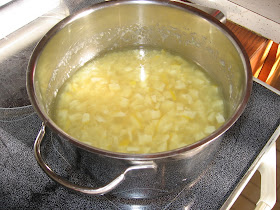
The gals over at the blog Doris And Jilly Cook have a recipe for Strawberry Lemon Marmalade that a friend of mine recently made and raved about, so I thought I'd give it a shot.
I've only begun canning and preserving in the past month or so, and had never before made jam or jelly. I love strawberries and lemons, and this time of year is perfect for tasty and inexpensive berries from my local grocery store, so I thought I'd have a go.
Sterilized half-pint jars. The recipe said it makes 4-5 half pints; I wound up with six. Thankfully I prepared an extra when I saw the quantity of marmalade that was cooking.

The gorgeous fresh strawberries I used. The original recipe is for frozen sugared berries; since they're in season, I used fresh, chopped them up, and sweetened them. I used about a quart and a half of whole berries to wind up with 4 cups of chopped. It may have contributed to the excess that I wound up with. It's impossible to know, when someone says to use a quart of berries, if their berries were smaller than mine, or if they were whole or chopped up.

Thinly sliced and chopped lemons are brought to a boil in water and left in their cooking liquid overnight. Next time, I'll use my mandoline slicer to get paper-thin slices.

Chopped sweetened berries and more sugar are added to the lemons and the whole mess is cooked until syrupy. See Doris and Jilly's blog for tips on getting the right consistency for gelling if you've never made jam before.

A couple of lessons were learned from this, my first jam-making experience.
One: Boiling marmalade/jam/preserves is the culinary equivalent of freshly spewed lava from Mt. Kilauea. Cook on a back burner so as to avoid splattering yourself with this sticky stuff that's about as hot as the sun. Thankfully, I thought about this beforehand and wasn't injured. Cleanup is also markedly easier if you wipe splatters and spills immediately with a warm wet towel. After it dries, good luck. Grease up those elbows.
Two: The recipe calls for 4 medium lemons. Three of mine were more on the large side, which I think accounted for part of having six half pints instead of 4 or 5. It also made the marmalade a little more tart than I might have preferred.
Three: This was a lot easier than I thought it would be, very rewarding, and definitely worth another batch eventually.





















